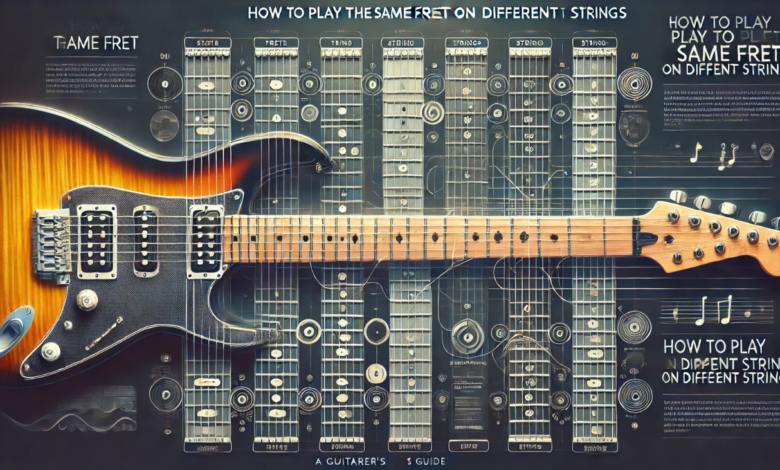How to Play the Same Fret on Different Strings: A Guitar Player’s Guide

As you progress in your guitar journey, one technique you’ll often encounter is playing the same fret on different strings. Whether you’re a beginner or a seasoned guitarist, mastering this skill can unlock a wealth of musical possibilities. In this article, we’ll explore how to play the same fret on different strings, discuss its benefits, and offer some tips for perfecting this technique.
Understanding the Guitar Fretboard Layout
Before diving into how to play the same fret on different strings, it’s important to have a basic understanding of the guitar fretboard. The guitar is laid out in a series of strings and frets, with each fret representing a specific musical note. When you press a string against a fret, you raise its pitch, producing a different note.
The strings on the guitar are numbered from 1 to 6, with the 1st string being the high E (the thinnest string) and the 6th string being the low E (the thickest string). The notes on each string follow a specific pattern, and the same fret on different strings often corresponds to the same note, just in a different octave.
Why Is This Technique Important?
You might be wondering why it’s crucial to learn how to play the same fret on different strings. There are several benefits to mastering this technique:
- Better Fretboard Navigation: Understanding how to play the same note on different strings helps you navigate the fretboard more efficiently. It allows you to access notes across multiple strings without needing to jump too far across the neck.
- Expanded Chord Shapes: Many chord shapes require you to play the same fret across different strings. Mastering this technique helps you build more complex chords and increases your versatility in playing.
- Scale and Soloing Flexibility: When improvising or playing scales, you’ll often find that the same note appears on multiple strings. Knowing how to play the same fret on different strings will enable you to shift positions smoothly and add variation to your solos.
How to Play the Same Fret on Different Strings
Now, let’s dive into how to play the same fret on different strings. This is a technique that can initially seem tricky, but with practice, it becomes second nature. Here’s a step-by-step guide:
- Choose a Fret to Practice: Start by choosing a fret to work with, such as the 5th fret. On the 6th string (low E), the 5th fret is the note A. The 5th fret on the 5th string (A) is D, the 5th fret on the 4th string (D) is G, and so on. Practice pressing down the 5th fret on different strings to familiarize yourself with the note locations.
- Use Your Index Finger: When you’re playing the same fret on different strings, use your index finger for all the strings. This helps maintain consistency and makes the technique easier to manage. If you find it difficult to reach all the strings, try adjusting the angle of your hand for better access.
- Focus on Precision: It’s crucial to press down on the correct fret without muting adjacent strings. For example, when playing the 5th fret on the 6th string, ensure that the 5th fret on the 5th string is also properly sounded. This might take some practice, but focusing on precision will help you develop clean, clear notes.
- Start Slow and Build Speed: Begin practicing slowly, focusing on clean note production. Gradually increase your speed as you become more comfortable with the technique. Playing at a slow pace ensures you develop muscle memory and accuracy.
- Practice in Different Keys: Once you’re comfortable with one fret, start practicing the same technique across different frets and in different keys. This helps you build versatility and become more comfortable navigating the entire fretboard.
Common Challenges and How to Overcome Them
While learning how to play the same fret on different strings is a valuable skill, it can come with a few challenges:
- Hand Fatigue: Pressing down the same fret on multiple strings can lead to hand fatigue, especially for beginners. To combat this, take regular breaks and practice hand stretches to improve your finger strength and flexibility.
- Fretting Hand Position: It’s easy to accidentally mute adjacent strings when playing the same fret on different strings. Ensure that your fretting hand is positioned correctly. Your thumb should rest lightly on the back of the neck, and your fingers should be curved and pressing down on the strings firmly but without excessive force.
- String Muting: Sometimes, you might accidentally mute one of the strings you’re not playing, especially if you’re not familiar with the technique. Use the edge of your palm to mute unused strings or ensure that your fretting hand fingers are not touching other strings unintentionally.
Practical Applications of This Technique
Now that you know how to play the same fret on different strings, let’s explore a few practical applications:
- Chord Inversions: Many chord inversions involve playing the same fret across different strings. This allows you to create different voicings of the same chord without moving too far across the fretboard.
- Power Chords: Power chords, often used in rock and metal, involve playing the same fret across multiple strings. This technique is key to playing these chords cleanly and efficiently.
- Scales and Solos: In many scales, you’ll encounter the same note on different strings. Knowing how to play the same fret on different strings can help you play scales more fluidly and create more interesting solos.
- Arpeggios: When playing arpeggios, which involve picking individual notes from a chord, you might need to play the same fret across multiple strings. This is especially true for barre chords, where you’re playing the same fret on all strings.
Conclusion
Mastering how to play the same fret on different strings is a crucial step in your guitar-playing journey. It allows for more efficient fretboard navigation, smoother chord transitions, and greater flexibility in scale and soloing. Whether you’re playing power chords, improvising solos, or building complex chord shapes, this technique is indispensable. With consistent practice, you’ll soon find that the fretboard opens up to you in new and exciting ways, offering endless musical possibilities. So, grab your guitar and start practicing how to play the same fret on different strings today!



